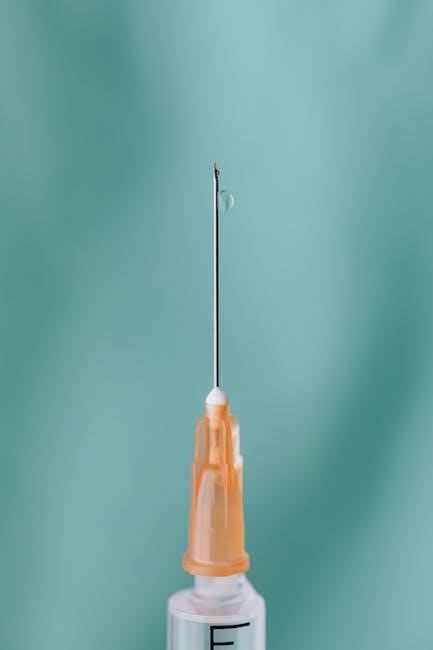Ultrasound-guided steroid injections offer a precise and effective treatment for joint and soft tissue pain, with costs influenced by location, practitioner expertise, and facility type.
Overview of the Procedure
Ultrasound-guided steroid injections are a minimally invasive procedure using real-time imaging to deliver corticosteroids directly to the affected area, ensuring precision and minimizing complications. This technique is commonly used to treat conditions like arthritis, tendinitis, and joint inflammation. The procedure typically begins with preparing the skin, followed by inserting a thin needle under ultrasound guidance to target the inflamed tissue. Patients often experience rapid pain relief, making it an effective treatment for chronic pain management. The cost of the procedure varies, but it generally starts from £200, depending on the facility and practitioner expertise. This method is favored for its accuracy and reduced risk of side effects compared to traditional injections.
Importance of Cost Considerations
Understanding the cost of ultrasound-guided steroid injections is crucial for patients to make informed decisions. Insurance coverage, out-of-pocket expenses, and facility fees vary widely, impacting accessibility. High costs may deter some, while others prioritize the procedure’s effectiveness. Comparing prices across providers and considering long-term benefits can help optimize financial decisions. While cost is a significant factor, it’s essential to balance it with the procedure’s accuracy and potential for lasting pain relief, ensuring value for money.

What is an Ultrasound-Guided Steroid Injection?
An ultrasound-guided steroid injection uses real-time imaging to precisely deliver corticosteroids into inflamed joints or tissues, minimizing pain and enhancing accuracy compared to traditional methods.
Definition and Purpose
An ultrasound-guided steroid injection is a minimally invasive procedure where corticosteroids are delivered directly into inflamed joints, tendons, or soft tissues under real-time ultrasound guidance. This technique ensures precise placement of the medication, maximizing therapeutic effects while minimizing systemic side effects. The primary purpose is to reduce inflammation, alleviate pain, and restore mobility in conditions like arthritis, tendinitis, or bursitis. By using ultrasound imaging, practitioners can accurately target the affected area, enhancing the procedure’s safety and efficacy compared to blind injections. This approach is particularly beneficial for patients seeking rapid symptom relief with minimal recovery time.
How the Procedure Works
The procedure begins with the patient positioned to access the affected area. A sterile needle is inserted under real-time ultrasound guidance, ensuring accurate placement of corticosteroids. The ultrasound provides clear visualization of the target tissue, allowing the practitioner to avoid nerves and blood vessels. Once the needle is correctly positioned, the steroid medication is injected. Patients may experience mild discomfort, but the use of ultrasound enhances precision, reducing potential complications. The process typically takes 15–30 minutes, with minimal recovery time. This method is highly effective for treating joint and soft tissue inflammation, offering both diagnostic and therapeutic benefits in a single session.

Factors Affecting the Cost of Ultrasound-Guided Steroid Injections

Costs vary based on location, practitioner expertise, facility type, and injection volume, with prices starting from £200 at specialized clinics like Practice Plus Group.
Location and Geography
Geographic location significantly influences the cost of ultrasound-guided steroid injections. Urban areas with higher living costs tend to charge more for procedures compared to rural regions. For instance, clinics in major cities may offer the procedure starting at £200, while smaller towns or less specialized facilities might provide it at a lower rate. Additionally, regions with limited access to ultrasound-guided injection specialists may experience higher fees due to increased demand and scarcity of practitioners. The variability in pricing highlights the importance of considering location when evaluating the cost of ultrasound-guided steroid injections.
Expertise of the Practitioner
The expertise of the practitioner significantly impacts the cost of ultrasound-guided steroid injections. High-volume practitioners with specialized training often charge higher fees due to their advanced skill level and the precision they bring to the procedure. For example, a clinic in High Wycombe offers ultrasound-guided injections starting at £200, reflecting the practitioner’s qualifications. Conversely, less experienced providers may charge lower rates, potentially compromising on accuracy or efficacy. The cost difference underscores the importance of prioritizing practitioner expertise for optimal outcomes, as higher fees may correlate with reduced risks of complications and improved long-term results. This makes the expertise of the practitioner a critical factor in both cost and effectiveness.
Facility Type and Equipment
The type of facility and the quality of equipment used significantly influence the cost of ultrasound-guided steroid injections. Specialized clinics, like Practice Plus Group in High Wycombe, charge around £200 for the procedure, reflecting the use of advanced ultrasound technology and sterile environments. Hospitals and high-end private facilities typically employ state-of-the-art equipment, increasing costs. Conversely, smaller outpatient centers or physician offices may offer lower rates due to lower overhead and more basic setups. The quality of imaging equipment and the availability of skilled technicians also play a role in pricing. While higher-end facilities may charge more, they often ensure greater accuracy and safety, making the investment worthwhile for many patients seeking effective pain relief.

Volume and Frequency of Injections
The volume and frequency of ultrasound-guided steroid injections can significantly impact their overall cost. Patients requiring multiple injections, such as those with chronic conditions like arthritis, may benefit from discounted rates for repeat procedures. Facilities often offer package deals or reduced rates for follow-up injections, making frequent treatments more affordable. Additionally, high-volume clinics may lower costs per injection due to operational efficiencies. However, insurance coverage and payment plans can also influence the frequency of treatments, as some policies may limit the number of covered injections. The total cost, therefore, depends on both the number of injections needed and the payment arrangements available. Consulting with a practitioner is essential to understand the financial implications of multiple treatments.

Average Cost of Ultrasound-Guided Steroid Injections
Ultrasound-guided steroid injections typically range between £200 to £500 per session, depending on the joint and facility. Costs may vary based on location and expertise.
Shoulder Injections
Ultrasound-guided shoulder injections are commonly used to treat conditions like arthritis, tendinitis, and rotator cuff injuries. The cost typically ranges between £200 to £500 per session, depending on the location and practitioner expertise. These injections deliver corticosteroids directly into the shoulder joint or surrounding tissues, providing targeted relief from inflammation and pain. The use of ultrasound ensures higher accuracy, reducing the risk of complications and improving outcomes. While costs may vary, the procedure is often covered by insurance for medically necessary cases. Patients experiencing chronic shoulder pain often find this treatment effective, with results lasting several months; It’s a preferred option for those seeking minimally invasive solutions.
Knee Injections
Ultrasound-guided knee injections are a common treatment for conditions like osteoarthritis, ligament sprains, and inflammatory joint pain. The cost typically ranges from £150 to £400 per session, depending on the facility and practitioner expertise. These injections deliver corticosteroids directly into the knee joint or surrounding soft tissues, reducing inflammation and pain. The precision of ultrasound guidance enhances accuracy, minimizing the risk of complications. Insurance often covers this procedure when deemed medically necessary. Patients with chronic knee pain frequently benefit from this treatment, experiencing relief that can last several months. It’s a popular choice for those seeking a minimally invasive approach to manage joint discomfort effectively.
Hip Injections
Ultrasound-guided hip injections are a popular treatment for conditions like osteoarthritis, bursitis, and inflammatory joint pain. The cost typically ranges from £150 to £400 per session, influenced by factors such as location and practitioner expertise. These injections deliver corticosteroids directly into the hip joint or surrounding soft tissues, providing significant pain relief. The use of ultrasound ensures precise needle placement, reducing the risk of complications. Insurance often covers this procedure when deemed medically necessary. Patients with chronic hip pain frequently benefit from this treatment, experiencing relief that can last several months. It’s a preferred option for those seeking a minimally invasive approach to manage hip discomfort effectively.
Spine and Epidural Injections
Ultrasound-guided spine and epidural injections are commonly used to treat chronic back pain, sciatica, and inflammation. The cost for these procedures typically ranges from £250 to £600 per session, depending on the complexity and location. Epidural injections target the spinal canal, delivering steroids to reduce inflammation and relieve pain. Ultrasound guidance enhances accuracy, minimizing risks. Insurance often covers these injections when medically necessary, such as for conditions like herniated discs or spinal stenosis. Patients often experience significant pain relief, making this a valuable option for managing chronic spinal conditions. The precision of ultrasound guidance improves efficacy and reduces the need for repeat procedures, offering long-term benefits for patients.

Insurance Coverage and Payment Options
Insurance coverage for ultrasound-guided steroid injections varies by provider, with Medicare and Medicaid covering some procedures. Private insurance policies differ, and out-of-pocket payment options are often available.
Medicare and Medicaid Coverage
Medicare and Medicaid provide coverage for ultrasound-guided steroid injections under specific conditions. These injections are typically covered when deemed medically necessary for conditions like arthritis or severe inflammation. Patients should verify their individual coverage, as policies may vary. Out-of-pocket costs may apply, depending on the patient’s plan and deductible status. Always consult with healthcare providers and insurance representatives to confirm coverage details and ensure eligibility for reimbursement. Proper documentation and pre-authorization may be required in some cases to secure coverage for these procedures.
Private Insurance Policies
Private insurance policies vary in their coverage of ultrasound-guided steroid injections, depending on the provider and the specific condition being treated. Many plans cover these injections for conditions like arthritis, tendinitis, and chronic pain, as they are considered medically necessary. However, coverage details, such as copays, deductibles, and coinsurance, differ across policies. Pre-authorization may be required in some cases to ensure reimbursement. Patients are advised to consult with their insurance provider to understand their coverage and any out-of-pocket costs associated with the procedure. Some policies may exclude certain types of injections or require proof of previous treatments. Always verify coverage before undergoing the procedure to avoid unexpected expenses.
Out-of-Pocket Payment Options
For patients without insurance coverage or those opting to pay out-of-pocket, ultrasound-guided steroid injections can range from $200 to $1,000 per session, depending on the location and facility. Many clinics offer payment plans or financing options to make the procedure more affordable. Some providers also provide discounts for multiple injections or package deals for ongoing treatments. Additionally, certain facilities accept credit cards or bank transfers for convenience; It’s important to consult with the healthcare provider or facility to discuss payment options and determine the best approach for your financial situation. Always inquire about any available discounts or promotions to reduce costs.

Comparing Costs: Ultrasound-Guided vs. Traditional Injections
Ultrasound-guided injections typically cost more due to advanced technology, ranging from $200 to $1,000, while traditional injections are cheaper, around $100 to $300, but less precise.
Cost Differences
Ultrasound-guided steroid injections generally cost more than traditional injections due to the advanced technology and expertise required. On average, ultrasound-guided injections can range from $200 to $1,000, depending on the location and facility. Traditional injections, while less precise, are typically cheaper, ranging from $100 to $300. The higher cost of ultrasound-guided procedures is justified by their increased accuracy, reducing the need for repeat injections. However, insurance coverage often varies, with some policies covering both methods, while others may only partially reimburse ultrasound-guided treatments. The cost difference reflects the trade-off between precision and affordability, making ultrasound-guided injections a more effective long-term option for many patients.
Efficacy and Accuracy
Ultrasound-guided steroid injections are highly effective due to their precision in delivering medication directly to the target tissue. Studies show that ultrasound guidance significantly improves accuracy compared to traditional blind injections, reducing the risk of misplacement. This precision leads to better clinical outcomes, particularly for conditions like carpal tunnel syndrome and joint pain. The real-time imaging ensures the steroid is administered exactly where needed, minimizing side effects and enhancing therapeutic benefits. While traditional injections may rely on anatomical landmarks, ultrasound guidance provides a more reliable and consistent approach, making it a preferred method for both accuracy and efficacy in pain management treatments.

Cost-Effectiveness of Ultrasound-Guided Injections
Ultrasound-guided injections significantly enhance accuracy by ensuring precise medication delivery, reducing side effects, and improving therapeutic outcomes. Real-time imaging allows practitioners to target specific tissues effectively, minimizing risks. This method is particularly beneficial for conditions like carpal tunnel syndrome, where accuracy is crucial. Studies indicate that ultrasound guidance leads to better clinical results compared to traditional blind injections, with fewer complications and improved patient satisfaction. The precision of ultrasound ensures that the steroid is administered exactly where needed, maximizing efficacy and reducing the likelihood of repeat procedures, thereby offering a more reliable and effective treatment option for managing joint and soft tissue pain.
Long-Term Benefits
Ultrasound-guided steroid injections provide sustained pain relief and improved joint function, reducing the need for long-term medication and invasive surgeries. By targeting inflammation precisely, these injections promote faster healing and restore mobility, minimizing the risk of chronic pain. Patients often experience lasting benefits, with reduced flare-ups and improved quality of life. The accuracy of ultrasound guidance ensures that the steroid is delivered directly to the affected tissue, enhancing its therapeutic effects. Over time, this can lead to significant cost savings by avoiding repetitive treatments and prolonged recovery periods. The long-term efficacy makes ultrasound-guided injections a valuable option for managing conditions like arthritis and tendinitis effectively.
Reduction in Repeat Procedures
Ultrasound-guided steroid injections often reduce the need for repeat procedures due to their high accuracy and effectiveness. By precisely targeting the affected area, these injections deliver the steroid directly to the inflamed tissue, enhancing therapeutic outcomes. This precision minimizes the likelihood of incomplete relief, which can lead to additional treatments. Patients typically experience longer-lasting pain relief, decreasing the frequency of follow-up injections. The reduced need for repeat procedures not only lowers overall healthcare costs but also spares patients from the inconvenience and discomfort of multiple treatments. This makes ultrasound-guided injections a more efficient and cost-effective option compared to traditional methods.

Ultrasound-guided steroid injections are a valuable option for managing pain, offering both effectiveness and cost-efficiency. They balance initial costs with long-term savings through reduced repeat procedures.
Final Thoughts on Cost and Value
Ultrasound-guided steroid injections offer a cost-effective solution for managing chronic pain, balancing initial expenses with long-term benefits. Their precision reduces the need for repeat procedures, lowering overall healthcare costs. While prices vary based on location and expertise, the improved accuracy and efficacy of ultrasound guidance often justify the investment. Insurance coverage and payment options further enhance accessibility, making these injections a valuable choice for patients seeking reliable pain relief. Despite higher upfront costs compared to traditional methods, the potential for sustained relief and reduced medical interventions make ultrasound-guided injections a smart, economical decision for many individuals. Their combination of effectiveness and financial practicality underscores their growing popularity in pain management.